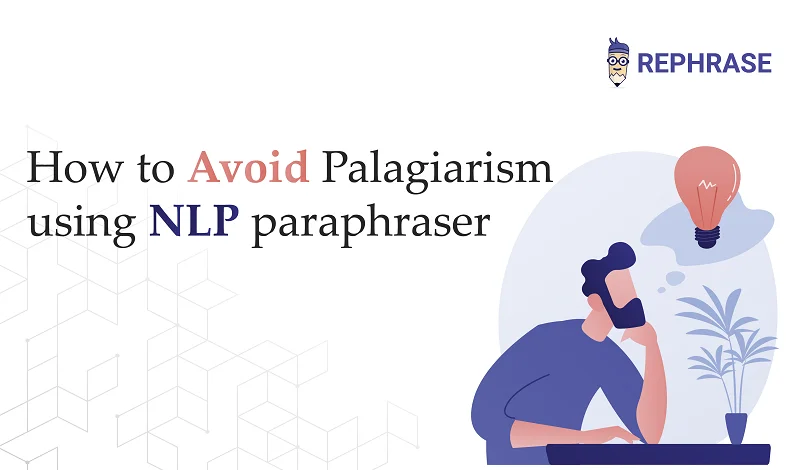
How To Avoid Plagiarism Using NLP Paraphraser
As the demand for more content is increasing, the issue of plagiarism is becoming more prominent than ever.
Information-based online businesses rely on consistently creating fresh and unique content to make their businesses stand out from the rest.
This need for content is giving rise to content plagiarism, which greatly hurts the efforts of original content creators.
As a result, search engines and government authorities are taking strict action against people involved in plagiarism to ensure that the original work remains safe and secure.
Whether the plagiarism is intentional or accidental, you need to get rid of it because using plagiarized content will not get you anywhere. In fact, it can have a negative impact on your content marketing strategy.
In this article, we will dive deeper into Plagiarism and learn how to avoid it using an NLP Paraphraser.
So, let’s get into it and talk about how you can avoid plagiarism using an NLP Paraphraser
What is Plagiarism?
Plagiarism is the copying of a person’s work and the use of the work without the consent of the original content creator.
Using plagiarized content is not good for a business because if anyone finds out, it will send off a bad impression, which will impact the business's sales.
Even for academic purposes, plagiarism destroys the cognitive abilities of students to be creative and come up with their ideas.
There are many ways and methods you can avoid plagiarism in your content. The easiest way to do this is to use an NLP Paraphraser.
What is an NLP Paraphrase Tool?
An NLP Paraphraser is an AI-Based Paraphrasing Tool that works on Natural Language Processing (NLP) principles. These paraphrases are incredibly smart tools that take a piece of content as input and rewrite it in a completely natural and original way.
The significance of paraphrasing tool is great for content marketers and for people who have to create written content a lot. Content Creator can use paraphrasing Tool to generate new content perspectives from the ideas of existing content.
An NLP Paraphraser is more than a simple content paraphraser. This tool works on Artificial Intelligence Algorithms to understand the context of writing before rewording it.
Once the tool understands the context, it rewrites the content naturally while ensuring it is well-structured and well-formatted.
How to Use the NLP Paraphraser to Avoid Plagiarism?
An NLP Paraphraser like rephrase.info makes it easier to avoid plagiarism in a piece of content without any hassle.
Here is how you can use a standard NLP Paraphraser to Avoid Plagiarism
- Copy & Paste your Content in the NLP Paraphraser
- Choose the language of the content
- Choose the kind of paraphrasing level you want
- Click on the Paraphrase Button to get the output
Tips for Avoiding Plagiarism in the Content
Removing Plagiarism from content is essential if you want to make it sound credible and trustworthy. If you try and use plagiarized content, people will know instantly whether you have created it yourself or not.
This will cost your marketing efforts a lot in the long run.
Here are some of the most effective tips that you can use to Avoid Plagiarism in the Content
-
Use an NLP Paraphraser
Rephrase.info is the best NLP Paraphraser that you can use to avoid plagiarism in your content.
If you are running out of time and you want a simple and effective solution for rewriting a piece of writing, you should check out this NLP Paraphraser.
This tool is quite interactive and offers multiple paraphrasing settings. Once you have chosen the settings, you’ll be able to get the output quickly.
-
Reword the Content Manually
If you don’t have access to an NLP Paraphraser, rewriting the content manually would be your only option. This will require you to understand the concept of the content first.
Once you know the concept, you can rewrite the content with your own words and style. It will be quite time-consuming, but it will help you improve your paraphrasing skills. And this skill can go a long way for you in the future.
-
Add Citations & Quotations
When rewriting content, you must use citations and quotations when presenting someone else’s idea.
Citations will show that the facts and figures described in the content have been taken from another source.
The quotation marks are meant to be used where you have no choice but to use the exact words described in the source content.
Make sure to use proper citations and quotations when and where necessary to avoid plagiarism in your content.
-
Recheck the Plagiarism
If you have written the entire piece of content by yourself, you won’t need to check it for plagiarism.
But you should still check for it just to be on the safe side. Accidental plagiarism can happen to anyone.
You can only create so much unique content, right? There are bound to be some similarities in your content with some piece of writing on the internet because there is just so much content out there.
Check content for plagiarism using an online plagiarism checker to ensure that there is no accidental plagiarism in your content.
Final Words
Avoiding Plagiarism in the content is quite simple these days, thanks to the NLP Paraphrasing tool. There are a lot of paraphrasing and rewriting tools out there that you can use to reword a piece of content.
We recommend that you check out the tools that work on AI and NLP principles if you want the most accurate and efficient performance.
The bottom line is that you need to ensure that your digital marketing strategy incorporates only plagiarism-free content to make it work to its fullest potential.

